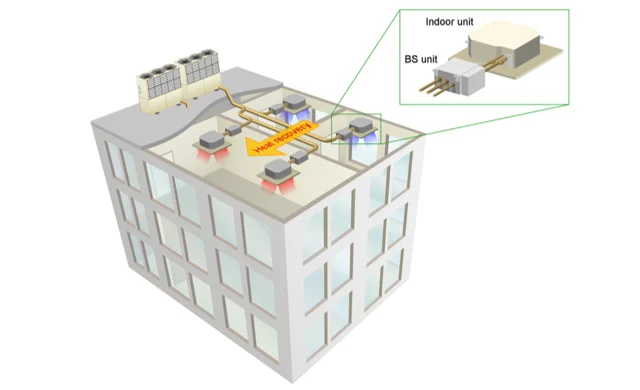Lower Operating Costs And Increased Energy Efficiency:
One of the most important advantages of VRF systems is their exceptional energy efficiency. Separate heating and cooling units are common in traditional HVAC systems, which can result in wasteful energy use and increased operating expenses. HRV systems, on the other hand, transmit energy from one area of the building to another by utilizing the heat exchange concept.
Heat Recovery VRF systems maximize energy use throughout the facility by utilizing waste heat. Users can anticipate lower electricity bills and total operating costs as a consequence, which makes them a desirable option for homeowners and companies looking to save long-term energy expenditures and their environmental impact.
Heating and Cooling at the Same Time:
The capacity of Heat Recovery VRF systems to deliver both heating and cooling in the same building at the same time is one of their best qualities. This feature is particularly helpful in buildings with spaces that demand varied temperatures, like offices with heat-generating equipment inside and quarters that need to be kept cool.
This would require several different systems in a standard HVAC system, which is not only inefficient but also expensive to construct and operate. A Heat Recovery VRF system eliminates the need for numerous units by meeting heating and cooling demands in real time. Because each zone may keep its preferred temperature without affecting others, occupant comfort levels are increased.
Better Comfort Management:
Precise temperature control is another benefit of Heat Recovery VRF systems. These systems allow users to adjust the temperature in various areas of a building, providing residents with individualized comfort. Because each indoor unit is separately controllable, people can change the temperature in any room to suit their tastes without impacting other rooms.
In establishments where comfort is crucial, like offices, hospitals, or hotels, this degree of personalization is quite beneficial. Additionally, HRV systems improve overall occupant happiness by maintaining a constant temperature and air quality indoors.
Increased Scalability and Flexibility:
Recovery of Heat Installation and system expansion are two areas where VRF systems provide exceptional flexibility. VRF systems are modular and may be installed with little disturbance, in contrast to typical HVAC systems, which may necessitate major changes to a building’s infrastructure. Multiple interior units can be reached by the flexible refrigerant piping, and the outdoor unit can be positioned at a convenient location.
This adaptability makes it simple to install mechanical systems in buildings with difficult layouts or little room. VRF systems can also be expanded or modified to accommodate a building’s evolving needs because they are scalable. A VRF system is easily adaptable to new zones or increased heating and cooling requirements, regardless of whether the building expands or has to replace outdated equipment.
Sustainability and Environmental Benefits:
Heat Recovery VRF systems are highly advantageous in this age of environmental consciousness. These systems lessen their influence on the environment and cut down on carbon emissions by using energy more efficiently. Conventional HVAC systems frequently use fossil fuels and are inefficient, which raises greenhouse gas emissions. On the other hand, VRF systems have a lower carbon footprint since they are more energy-efficient and can be fuelled by renewable energy sources.
Lower Space Needs and Installation Costs:
A Heat Recovery VRF system may cost more upfront than a standard HVAC system, but over time, installation costs are frequently lower for a variety of reasons. First, HRV systems reduce labour and material costs by doing away with the need for separate heating and cooling units, which require fewer components to be installed.
Second, both interior and outdoor units of HRV systems need less room due to their small design. Conventional HVAC systems frequently necessitate large air ducts and several heating and cooling units, which can occupy precious space in a structure. Heat Recovery VRF systems, on the other hand, use more compact and efficient units, which free up room for other purposes.
Upkeep and Durability:
Recovery of Heat VRF systems are renowned for their longevity and dependability. Over time, the technology behind these systems has changed, and manufacturers have added premium parts and cutting-edge engineering to guarantee longevity. These systems are a wise investment for building owners since they may function for many years with little downtime if they receive routine maintenance.
Additionally, compared to standard HVAC systems, VRF systems have fewer moving parts and require less maintenance, which usually results in cheaper continuing maintenance expenses. Because of their exceptional dependability and low maintenance needs, these systems have a lower total cost of maintenance.
Frequently Asked Questions:
1. What Elements Affect The Price Of Installing Air Conditioning?
System type (central, ductless, window), size and cooling capacity, labour expenses, ducting needs, energy efficiency, and any required permits all affect how much installing an air conditioner costs. It’s crucial to take into account every component because they all have a big impact on the overall installation cost.
2. What Is The Duration Required To Install An Air Conditioner?
The type of system determines how long the installation takes. Ductless mini-split systems may be installed in roughly three to four hours, but central air conditioning systems usually take six to eight hours. Depending on the conditions and experience of the installer, window units can often be installed in 1 to 2 hours.


